Signals & Systems
(Second Edition)
—Learning Instructions
(Exercises Answers)
Department of Computer Engineering
2005.12
�
Contents
Chapter 1 ······················································· 2
Chapter 2 ······················································· 17
Chapter 3 ······················································· 35
Chapter 4 ······················································· 62
Chapter 5 ······················································· 83
Chapter 6 ······················································· 109
Chapter 7 ······················································· 119
Chapter 8 ······················································· 132
Chapter 9 ······················································· 140
Chapter 10 ·······················································160
1
�
Chapter 1 Answers
1.1 Converting from polar to Cartesian coordinates:
1.2 converting from Cartesian to polar coordinates:
,
,
,
,
,
1.3. (a)
=
,
=0, because
,
.Therefore,
=
=
=
,
(b)
=
(c)
=cos(t). Therefore,
=
=
=
(d)
,
. Therefore,
=0,because
< .
=
=
,
(e)
(f)
=
=
=
=
,
=1. therefore,
=
=
,
. Therefore,
=
=
=
,
.
1.4. (a) The signal x[n] is shifted by 3 to the right. The shifted signal will be zero for n<1, And n>7.
(b) The signal x[n] is shifted by 4 to the left. The shifted signal will be zero for n<-6. And n>0.
(c) The signal x[n] is flipped signal will be zero for n<-1 and n>2.
(d) The signal x[n] is flipped and the flipped signal is shifted by 2 to the right. The new Signal will be
zero for n<-2 and n>4.
(e) The signal x[n] is flipped and the flipped and the flipped signal is shifted by 2 to the left.
1.5. (a) x(1-t) is obtained by flipping x(t) and shifting the flipped signal by 1 to the right.
Therefore, x (1-t) will be zero for t>-2.
(b) From (a), we know that x(1-t) is zero for t>-2. Similarly, x(2-t) is zero for t>-1,
(c) x(3t) is obtained by linearly compression x(t) by a factor of 3. Therefore, x(3t) will be
This new signal will be zero for n<-6 and n>0.
Therefore, x (1-t) +x(2-t) will be zero for t>-2.
zero for t<1.
2
111cos222je111cos()222je2cos()sin()22jjje2cos()sin()22jjje522jjjee42(cos()sin())1442jjje944122jjjee944122jjjee412jje055je22je233jje21322jje412jje2221jje4(1)jje411jje122213jjeE4014tdtePE(2)42()jttxe2()1txE22()dttxdtP211limlim222()TTTTTTdtdtTTtxlim11T2()txE23()dttx2cos()dttP2111(2)1limlim2222cos()TTTTTTCOStdtdtTTt1[][]12nnunx2[]11[]4nunnxE204131[]4nnnxPE2[]nx()28nje22[]nxE22[]nxP211limlim1122121[]NNNNnNnNNNnx3[]nxcos4nE23[]nx2cos()4n2cos()4nP1limcos214nNNnNN1cos()112lim()2122NNnNnN�
(d) x(t/3) is obtained by linearly compression x(t) by a factor of 3. Therefore, x(3t) will be
(b) x2[n]=1 for all n. Therefore, it is periodic with a fundamental period of 1.
(c) x3[n] is as shown in the Figure S1.6.
zero for t<9.
1.6 (a) x1(t) is not periodic because it is zero for t<0.
…
x3[n
…
…
-3
1
1
]
-4
…
…
1.7. (a)
1
4
5
…
…
…
n
0
…
…
1
…
-1
…
…
…
-1
Therefore, it is periodic with a fundamental period of 4.
-1
=
Therefore,
is zero for
>3.
(b) Since x1(t) is an odd signal,
is zero for all values of t.
(c)
Therefore,
is zero when
<3 and when
(d)
Therefore,
is zero only when
.
1.8. (a)
(b)
(c)
(d)
.
1.9. (a)
is a periodic complex exponential.
(b)
is a complex exponential multiplied by a decaying exponential. Therefore,
(c)
is not periodic.
is a periodic signal.
=
=
.
is a complex exponential with a fundamental period of
(d)
is a periodic signal. The fundamental period is given by N=m(
.
)
=
By choosing m=3. We obtain the fundamental period to be 10.
(e)
is not periodic.
is a complex exponential with
=3/5. We cannot find any integer m
such that m(
) is also an integer. Therefore,
is not periodic.
1.10.
x(t)=2cos(10t+1)-sin(4t-1)
Period of first term in the RHS =
Period of first term in the RHS =
.
.
Therefore, the overall signal is periodic with a period which the least common
multiple of the periods of the first and second terms. This is equal to
.
3
1[]vnx1111[][]([][4][][4])22nnununununxx1[]vnx1[]nx2[]vnx11311[][][][3][3]221122vnnnnnununxxx3 []vnxnn1554411()(()())(2)(2)22vtttttututxxxee4()vtxt01{()}22cos(0)tttxe02{()}2cos()cos(32)cos(3)cos(30)4tttttxe3{()}sin(3)sin(3)2tttttxee224{()}sin(100)sin(100)cos(100)2tttttttxeee1()tx101021()jtjttjxee2()tx2()tx3[]nx3[]nx7jnejne3[]nx224[]nx23/510().3m5[]nx5[]nx0w02w5[]nx2105242�
1.11.
x[n] = 1+
−
Period of first term in the RHS =1.
Period of second term in the RHS =
=7 (when m=2)
Period of second term in the RHS =
=5 (when m=1)
Therefore, the overall signal x[n] is periodic with a period which is the least common
Multiple of the periods of the three terms inn x[n].This is equal to 35.
1.12. The signal x[n] is as shown in figure S1.12. x[n] can be obtained by flipping u[n] and then
Shifting the flipped signal by 3 to the right. Therefore, x[n]=u[-n+3]. This implies that
M=-1 and no=-3.
1.13
y(t)=
X[n]
-3
-2
-1
0
1
2
3
n
Figure S 1.12
=
=
Therefore
1
-1
0
1
2
t
0
x(t)
g(t)
1.14 The signal x(t) and its derivative g(t) are shown in Figure S1.14.
Therefore
Figure S 1.14
-2
-1
-3
2
t
1
-3
)
This implies that A =3, t =0, A =-3, and t =1.
1.15 (a) The signal x [n], which is the input to S , is the same as y [n].Therefore ,
y [n]= x [n-2]+
x [n-3]
= y [n-2]+
y [n-3]
=2x
[n-2] +4x
[n-3] + ( 2x [n-3]+ 4x [n-4])
=2x [n-2]+ 5x [n-3] + 2x [n-4]
The input-output relationship for S is
y[n]=2x[n-2]+ 5x [n-3] + 2x [n-4]
4
74jne25jne7/425/22tdtx)(dtt))2()2((2,022,12,0,ttt224dtEkkktkttg12(3)2(3)(1122221222121211112111111�
(b) The input-output relationship does not change if the order in which S and S are connected series
reversed. . We can easily prove this assuming that S follows S . In this case , the signal x [n], which is the
input to S is the same as y [n].
Therefore y [n] =2x [n]+ 4x [n-1]
= 2y [n]+4 y [n-1]
=2( x [n-2]+
x [n-3] )+4(x [n-3]+
x [n-4])
=2 x [n-2]+5x [n-3]+ 2 x [n-4]
The input-output relationship for S is once again
1.16 (a)The system is not memory less because y[n] depends on past values of x[n].
(b)The output of the system will be y[n]=
=0
y[n]=2x[n-2]+ 5x [n-3] + 2x [n-4]
(c)From the result of part (b), we may conclude that the system output is always zero for inputs of the
form
, k ґ. Therefore , the system is not invertible .
1.17 (a) The system is not causal because the output y(t) at some time may depend on future values of x(t). For
instance , y(-
)=x(0).
(b) Consider two arbitrary inputs x (t)and x (t).
x (t)
y (t)= x (sin(t))
x (t)
y (t)= x (sin(t))
Let x (t) be a linear combination of x (t) and x (t).That is , x (t)=a x (t)+b x (t)
Where a and b are arbitrary scalars .If x (t) is the input to the given system ,then the corresponding output
y (t) is y (t)= x ( sin(t))
=a x (sin(t))+ x (sin(t))
=a y (t)+ by (t)
Therefore , the system is linear.
1.18.(a) Consider two arbitrary inputs x [n]and x [n].
x [n]
y [n] =
x [n ]
y [n] =
Let x [n] be a linear combination of x [n] and x [n]. That is :
x [n]= ax [n]+b x [n]
where a and b are arbitrary scalars. If x [n] is the input to the given system, then the corresponding output
y [n] is y [n]=
=
=a
+b
Therefore the system is linear.
(b) Consider an arbitrary input x [n].Let
= ay [n]+b y [n]
5
12121121112222122212222]2[][nn][kn12111222312312333312121211][001kxnnnnk22][002kxnnnnk312312333][003kxnnnnk])[][(2100kbxkaxnnnnk][001kxnnnnk][002kxnnnnk121�
y [n] =
be the corresponding output .Consider a second input x [n] obtained by shifting x [n] in time:
The output corresponding to this input is
x [n]= x [n-n ]
y [n]=
=
=
Also note that y [n- n ]=
.
Therefore , y [n]= y [n- n ]
This implies that the system is time-invariant.
(c) If
Also note that y [n- n ]= x
[n-2- n ]
Therefore , y [n]= y [n- n ]
This implies that the system is time-invariant.
(c) (i) Consider two arbitrary inputs x [n]and x [n].
x [n]
y [n] = x [n+1]- x [n-1]
x [n ]
y [n] = x [n+1 ]- x [n -1]
Let x [n] be a linear combination of x [n] and x [n]. That is :
x [n]= ax [n]+b x [n]
where a and b are arbitrary scalars. If x [n] is the input to the given system, then the
corresponding output y [n] is y [n]= x [n+1]- x [n-1]
=a(x [n+1]- x [n-1])+b(x [n +1]- x [n -1])
=a x [n+1]+b x [n +1]-a x [n-1]-b x [n -1]
Therefore the system is linear.
(ii) Consider an arbitrary input x [n].Let y [n]= x [n+1]- x [n-1]
= ay [n]+b y [n]
be the corresponding output .Consider a second input x [n] obtained by shifting x [n] in time: x [n]=
x [n-n ]
The output corresponding to this input is
Also note that y [n-n ]= x [n+1- n ]- x [n-1- n ]
y [n]= x [n +1]- x [n -1]= x [n+1- n ]- x [n-1- n ]
Therefore , y [n]= y [n-n ]
This implies that the system is time-invariant.
(d) (i) Consider two arbitrary inputs x (t) and x (t).
x (t)
y (t)=
x (t)
y (t)=
Let x (t) be a linear combination of x (t) and x (t).That is x (t)=a x (t)+b x (t)
where a and b are arbitrary scalars. If x (t) is the input to the given system, then the corresponding output
y (t) is y
(t)=
=
=a
+b
= ay (t)+b y (t)
Therefore the system is linear.
(ii) Consider an arbitrary inputs x (t).Let
y (t)=
=
be the corresponding output .Consider a second input x (t) obtained by shifting x (t) in time:
The output corresponding to this input is
y (t)=
=
x (t)= x (t-t )
Also note that y (t-t )=
Therefore the system is not time-invariant.
=
y (t)
7
10120210121111222231231233333121211221211112121022210101010102101211d(t) x122(t) x2d312312333d(t) x3(t) xb+(t) ax21dd(t) x1(t) x2d1211d(t) x12)(x-(t) x11t212102(t) x2d2)(x-(t) x22t2)(x-)t-(t x0101tt102)(x-)t-(t x0101tt2�
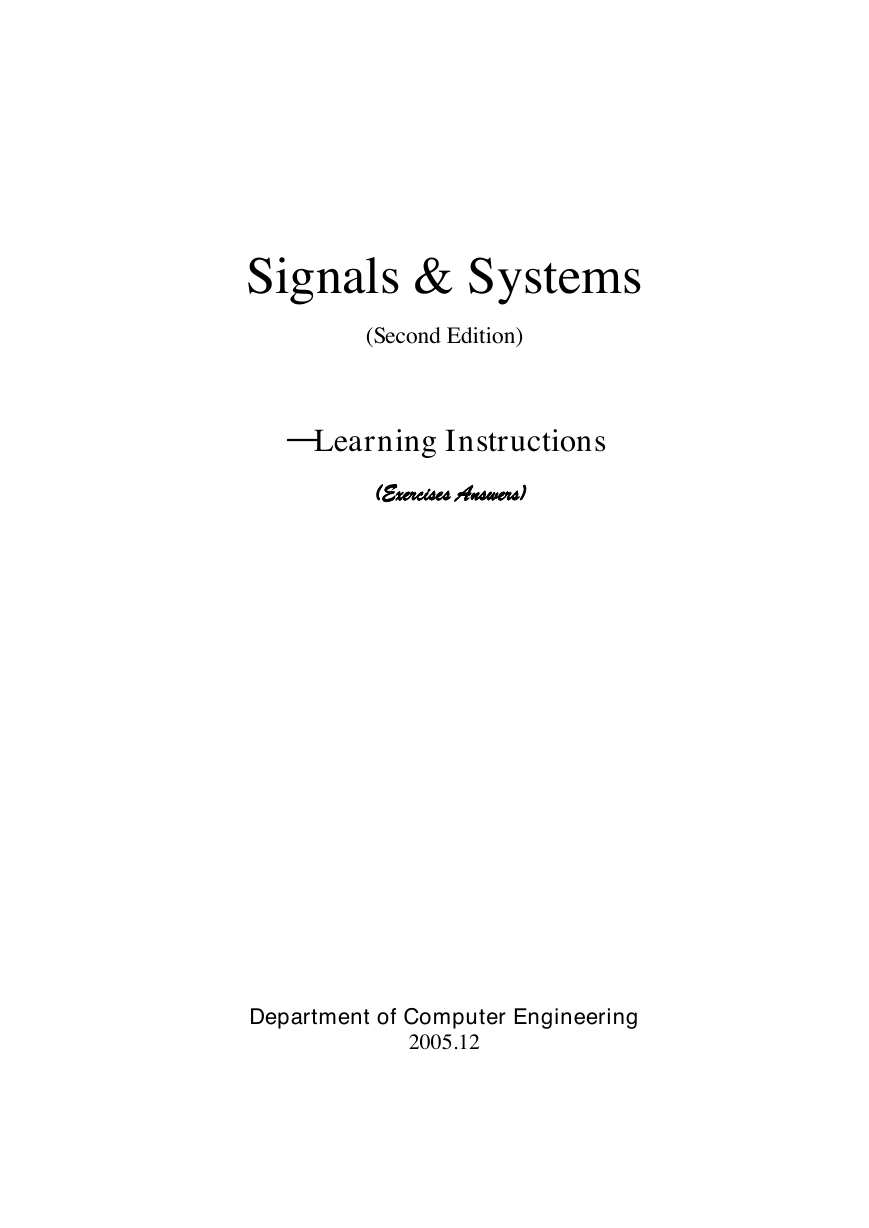
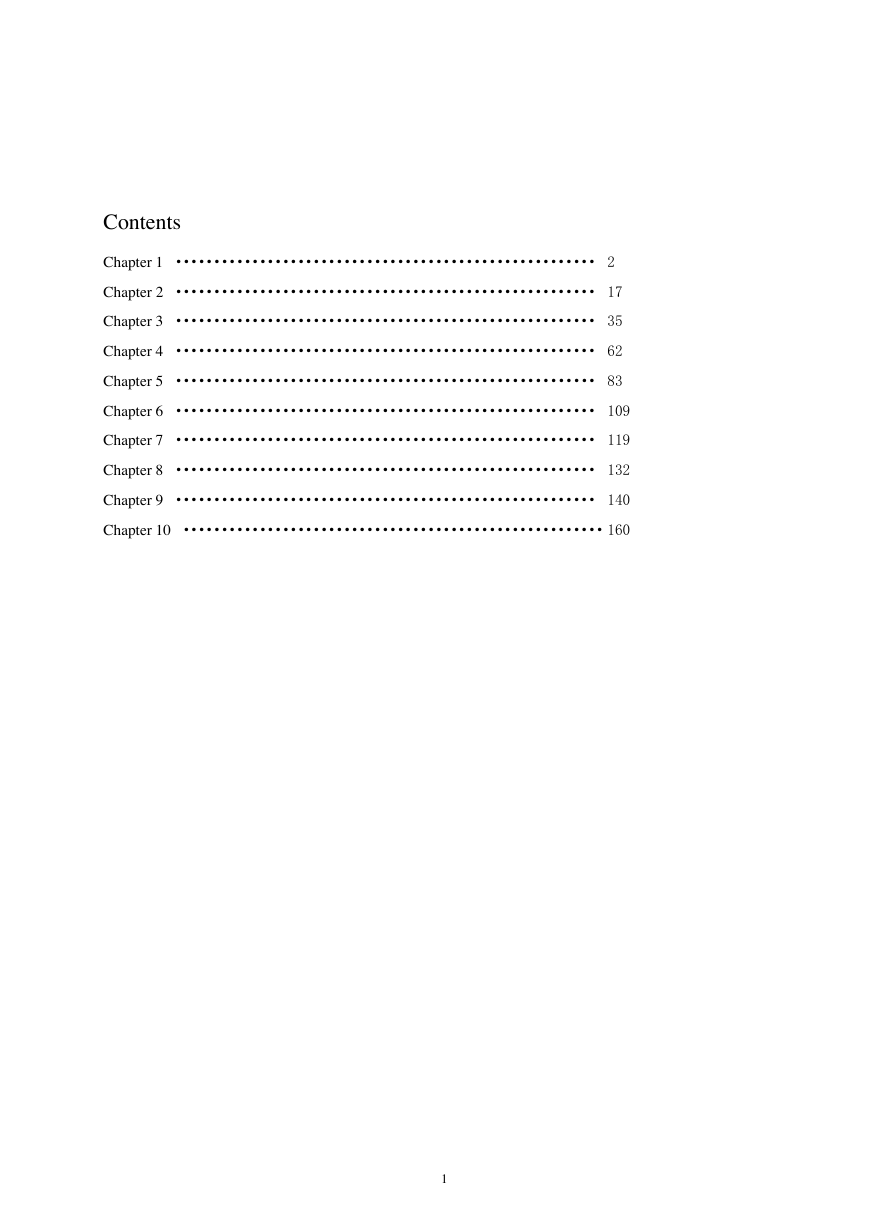
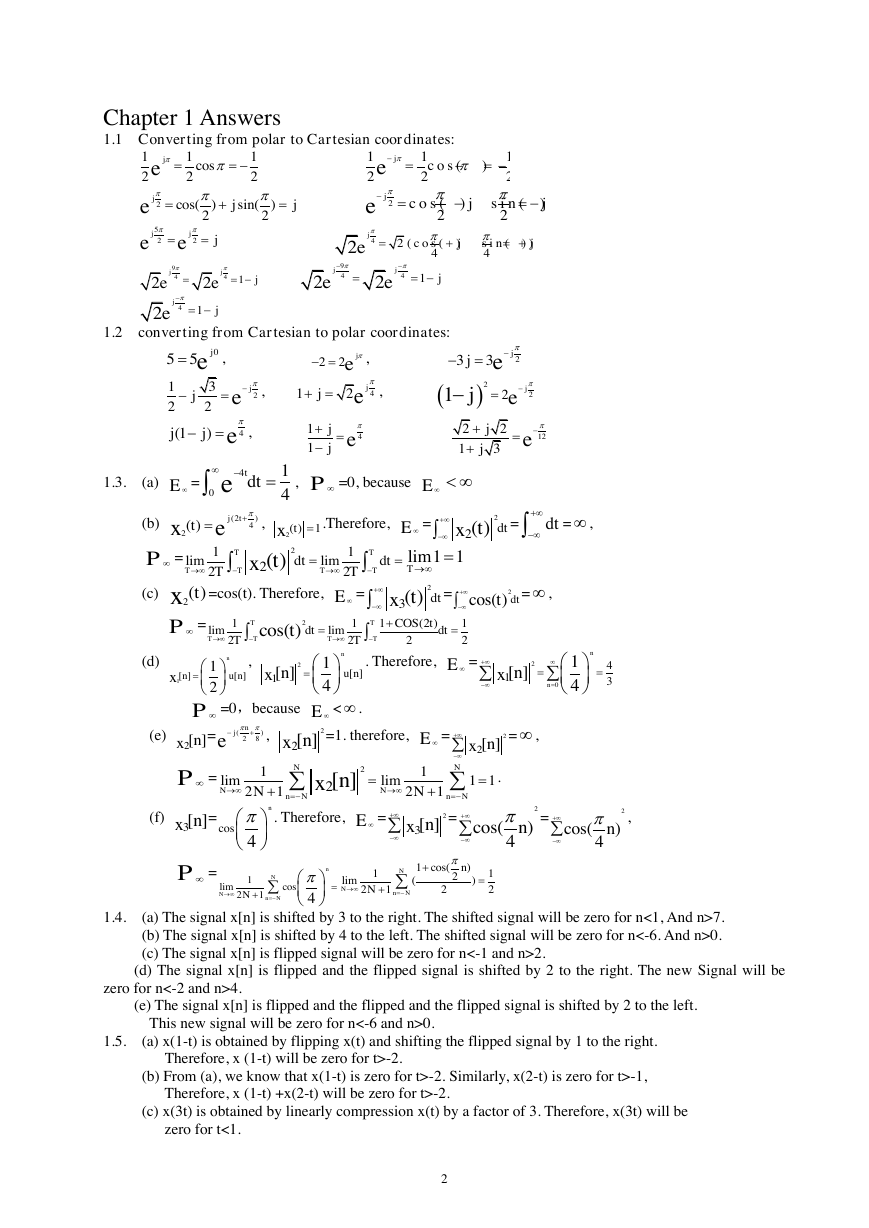

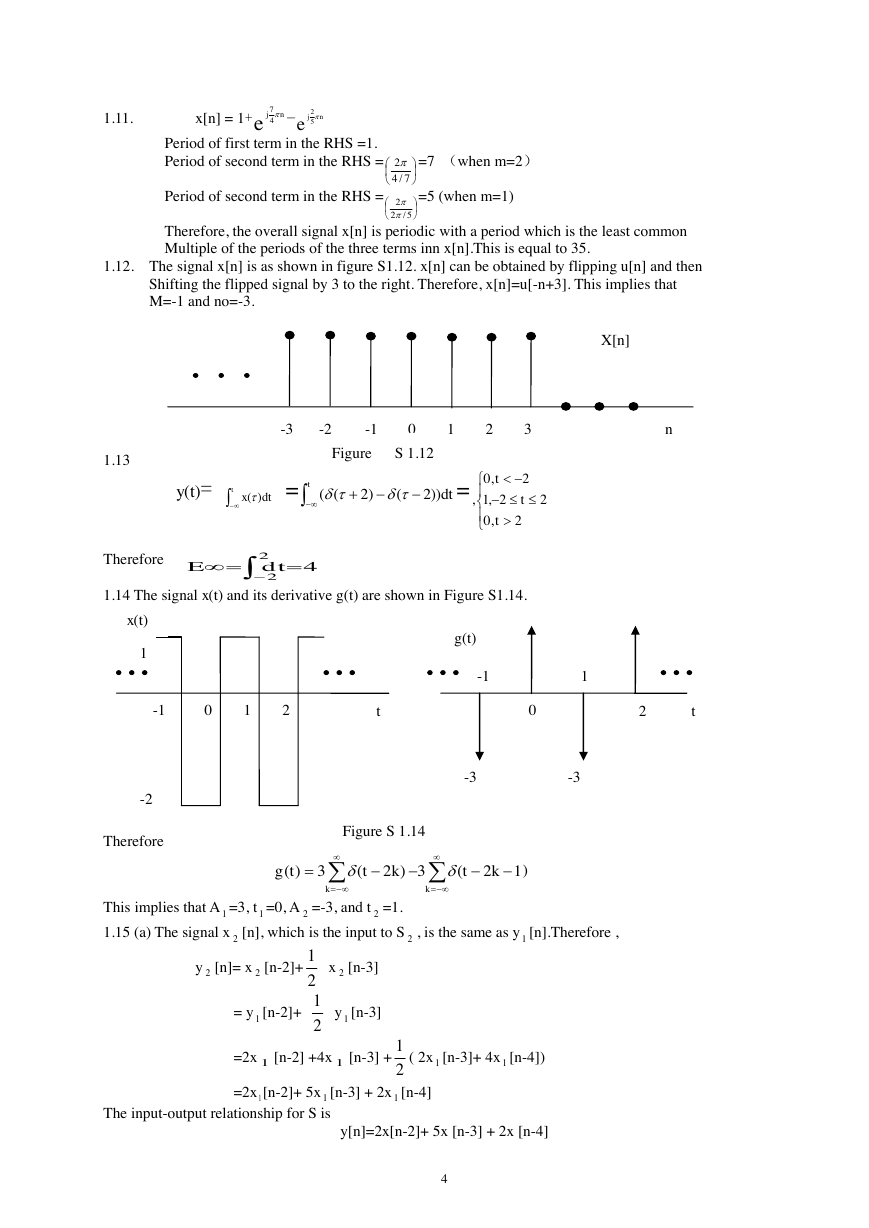


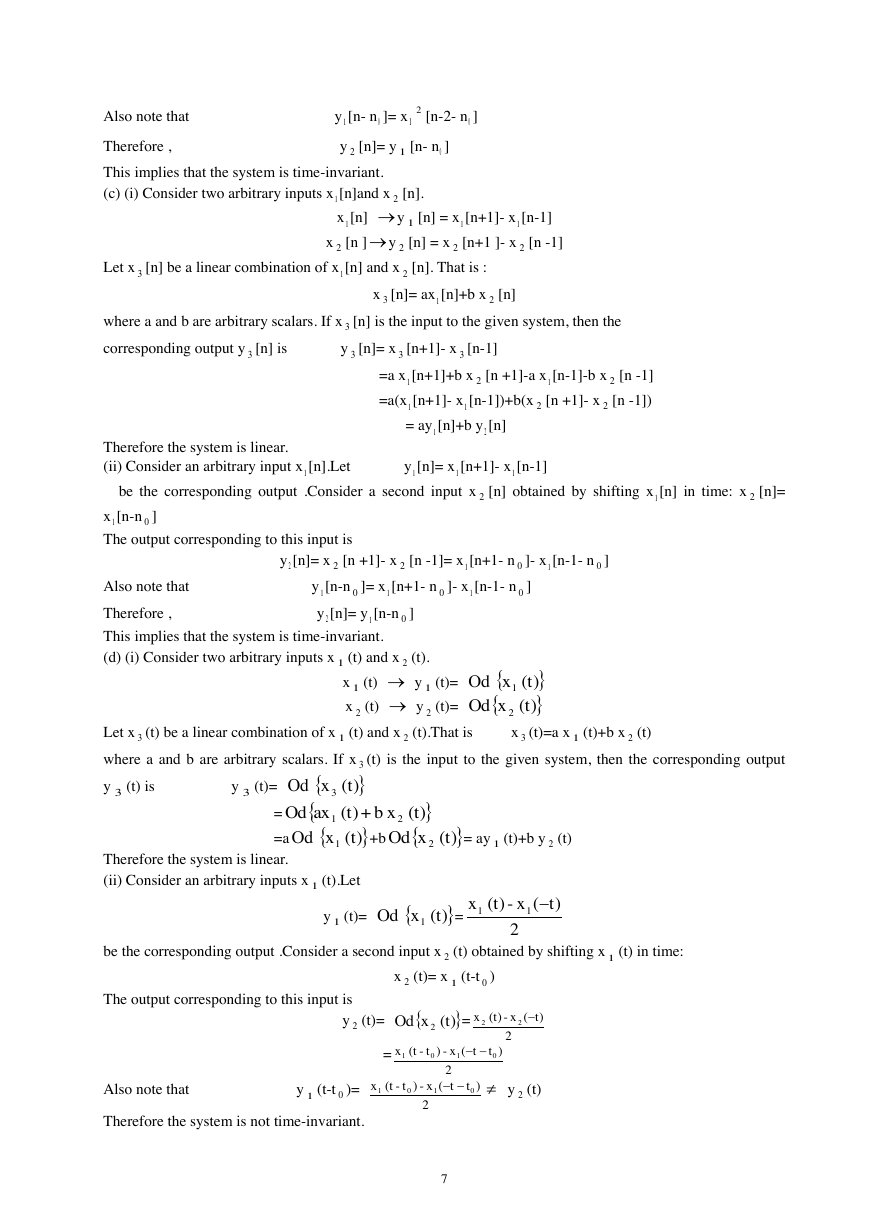








 2023年江西萍乡中考道德与法治真题及答案.doc
2023年江西萍乡中考道德与法治真题及答案.doc 2012年重庆南川中考生物真题及答案.doc
2012年重庆南川中考生物真题及答案.doc 2013年江西师范大学地理学综合及文艺理论基础考研真题.doc
2013年江西师范大学地理学综合及文艺理论基础考研真题.doc 2020年四川甘孜小升初语文真题及答案I卷.doc
2020年四川甘孜小升初语文真题及答案I卷.doc 2020年注册岩土工程师专业基础考试真题及答案.doc
2020年注册岩土工程师专业基础考试真题及答案.doc 2023-2024学年福建省厦门市九年级上学期数学月考试题及答案.doc
2023-2024学年福建省厦门市九年级上学期数学月考试题及答案.doc 2021-2022学年辽宁省沈阳市大东区九年级上学期语文期末试题及答案.doc
2021-2022学年辽宁省沈阳市大东区九年级上学期语文期末试题及答案.doc 2022-2023学年北京东城区初三第一学期物理期末试卷及答案.doc
2022-2023学年北京东城区初三第一学期物理期末试卷及答案.doc 2018上半年江西教师资格初中地理学科知识与教学能力真题及答案.doc
2018上半年江西教师资格初中地理学科知识与教学能力真题及答案.doc 2012年河北国家公务员申论考试真题及答案-省级.doc
2012年河北国家公务员申论考试真题及答案-省级.doc 2020-2021学年江苏省扬州市江都区邵樊片九年级上学期数学第一次质量检测试题及答案.doc
2020-2021学年江苏省扬州市江都区邵樊片九年级上学期数学第一次质量检测试题及答案.doc 2022下半年黑龙江教师资格证中学综合素质真题及答案.doc
2022下半年黑龙江教师资格证中学综合素质真题及答案.doc